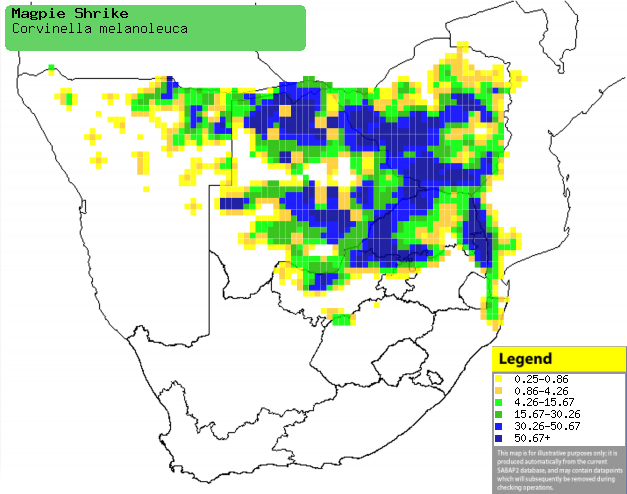|
Corvinella melanoleuca (Magpie
shrike, Long-tailed shrike)
Langstertlaksman [Afrikaans]; umQonqotho [Zulu]; Muruli
[Kwangali]; Ncilongi [Tsonga]; Motsilodi, Tilodi [Tswana]; Eksterklauwier
[Dutch]; Corvinelle noir et blanc [French]; Elsterwürger [German];
Picanço-rabilongo [Portuguese]
Life
> Eukaryotes >
Opisthokonta
> Metazoa (animals) >
Bilateria >
Deuterostomia > Chordata >
Craniata > Vertebrata (vertebrates) > Gnathostomata (jawed
vertebrates) > Teleostomi (teleost fish) > Osteichthyes (bony fish) > Class:
Sarcopterygii (lobe-finned
fish) > Stegocephalia (terrestrial
vertebrates) > Tetrapoda
(four-legged vertebrates) > Reptiliomorpha > Amniota >
Reptilia (reptiles) >
Romeriida > Diapsida > Archosauromorpha > Archosauria >
Dinosauria
(dinosaurs) > Saurischia > Theropoda (bipedal predatory dinosaurs) >
Coelurosauria > Maniraptora > Aves
(birds) > Order: Passeriformes
> Family: Laniidae
Distribution and habitat
It has three separate populations - one in Kenya and
Tanzania, another in Malawi and northern Mozambique and the largest one from
Angola and Zambia to southern Africa. Here it locally common in Zimbabwe,
Botswana, north-eastern Namibia, Limpopo Province, Gauteng and North-West
Province. It favours open savanna woodland with short grass clumps and bare
ground, also occurring in broad-leaved woodland and disturbed areas with
Acacia tree stands, such as in suburban gardens and town parks.
|
 |
|
Distribution of Magpie shrike in southern Africa,
based on statistical smoothing of the records from first SA Bird Atlas
Project (©
Animal Demography unit, University of
Cape Town; smoothing by Birgit Erni and Francesca Little). Colours range
from dark blue (most common) through to yellow (least common).
See here for the latest distribution
from the SABAP2. |
Food
It mainly eats insects, using a variety of foraging
techniques. It often perches in a prominent position, searching for a food item.
Once it spots something it dives to the ground and catches it. It also gleans
prey from leaves and branches, and sometimes searches for them at ground level. The following food items have been recorded in its diet:
Breeding
- A facultative cooperative breeder, meaning that the breeding pair or
assisted by 1-3 helpers who are usually juveniles from the previous brood.
- Nest construction is handled by both sexes - group members have never
been observed assisting them. It basically consists of an untidy cup made of
twigs, grass stems and roots, typically placed in the upper branches of an
Acacia tree.
- Egg-laying season peaks from October-January.
- It lays 2-6 eggs, which are incubated solely by the female for about 16
days, the male and group members providing her with food.
- The chicks are cared for both parents and group members, leaving the
nest after about 15-19 days. As it usually lays two clutches per breeding
season the fledglings help to rear the next brood.
Threats
Not threatened.
Links
References
-
Hockey PAR, Dean WRJ and Ryan PG 2005. Roberts
- Birds of southern Africa, VIIth ed. The Trustees of the John Voelcker
Bird Book Fund, Cape Town.
|
